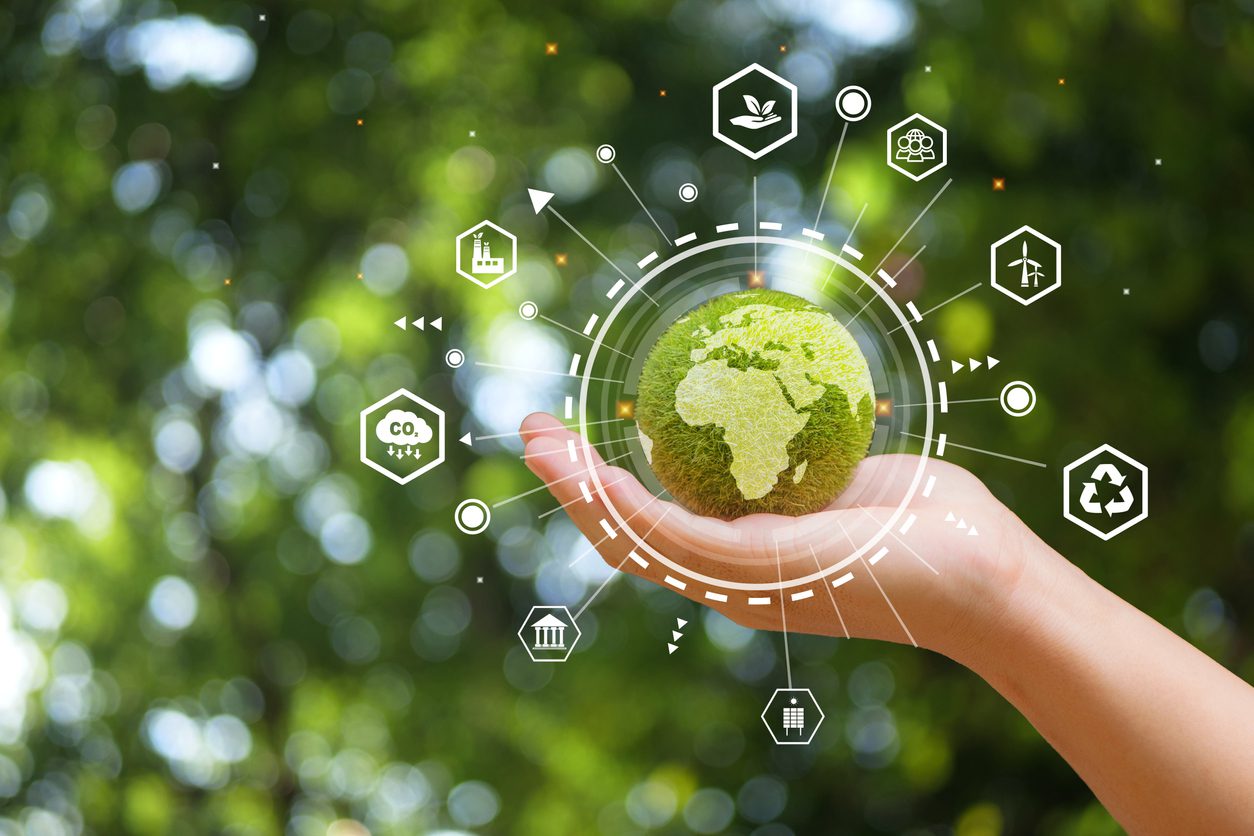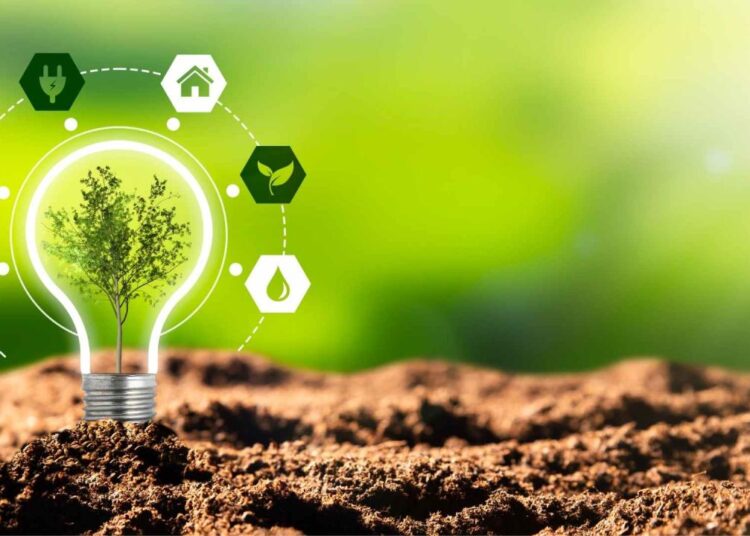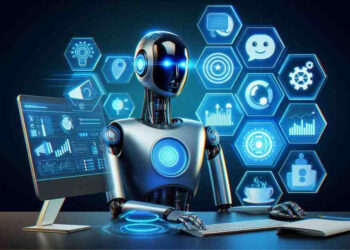Clean Energy Generation and Storage

At the core of a sustainable future lies the ability to generate and store clean energy efficiently, moving away from fossil fuels to renewable, low-carbon alternatives.
A. Next-Generation Solar Photovoltaics: While conventional silicon solar panels have driven significant growth in renewable energy, next-generation solar photovoltaics are pushing the boundaries of efficiency, versatility, and cost-effectiveness. Perovskite solar cells, for example, offer high power conversion efficiencies, are flexible, lightweight, and can even be made transparent, opening up applications for building-integrated photovoltaics (BIPV) in windows and facades. These advancements allow buildings to generate their own power seamlessly, blending into urban aesthetics. Thin-film solar technologies (e.g., CIGS, CdTe) are reducing material usage and allowing for flexible, rollable panels suitable for unconventional surfaces like vehicle roofs or portable chargers, making solar energy more adaptable. Furthermore, innovations in tandem solar cells, which stack different materials to capture a broader spectrum of sunlight, are achieving record efficiencies, promising more power generation from smaller footprints. This means more electricity can be produced per square meter, making solar viable in areas with limited space. These advancements are making solar energy more adaptable and competitive across diverse environments, from arid deserts to urban skylines.
B. Advanced Wind Turbine Technologies: Wind power continues its upward trajectory with advanced wind turbine technologies that are taller, more efficient, and capable of operating in diverse conditions. Offshore wind farms are seeing the development of massive turbines (15+ MW) with enormous rotor diameters, capturing stronger, more consistent winds far from land. These colossal turbines, often taller than skyscrapers, can power tens of thousands of homes each. Innovations in blade design (e.g., segmented, telescopic, or morphing blades that can adapt to wind speeds), direct-drive generators (eliminating gearboxes for reduced maintenance and improved reliability), and floating offshore platforms (for deeper waters where fixed-bottom foundations aren’t feasible) are enhancing energy capture and reducing the levelized cost of electricity. Furthermore, research into airborne wind energy systems (AWES) using kites or drones promises to tap into higher-altitude, stronger winds, offering a glimpse into a future where wind energy harvesting is less constrained by fixed towers.
C. Grid-Scale Energy Storage Solutions: The intermittency of solar and wind power necessitates robust grid-scale energy storage solutions to ensure a stable and reliable electricity supply. Beyond traditional pumped-hydro, lithium-ion battery mega-packs (like Tesla’s Megapack) are being deployed globally to store excess renewable energy during periods of high generation and discharge it during peak demand or low generation. Emerging technologies like flow batteries offer longer durations (hours to days) and greater scalability, ideal for daily and seasonal shifting of renewable energy, and they typically have a longer lifespan than lithium-ion batteries. Additionally, innovations in compressed air energy storage (CAES), liquid air energy storage (LAES), and advanced thermal storage systems are providing diverse options for balancing the grid, making high penetrations of renewable energy feasible and ensuring consistent power delivery even when the sun isn’t shining or the wind isn’t blowing.
D. Smart Grids and Energy Management Systems: To optimize the integration of diverse renewable sources and manage complex demand patterns, smart grids and intelligent energy management systems are crucial. These utilize a network of sensors, real-time data analytics, and Artificial Intelligence (AI) to monitor, predict, and optimize energy flow from generation to consumption. Smart meters provide granular consumption data, empowering consumers with insights into their usage and enabling dynamic pricing and demand response programs where consumers can adjust their energy use based on real-time prices. AI algorithms can forecast renewable energy output (e.g., predicting solar production based on weather), predict demand peaks, and intelligently dispatch stored energy or adjust loads across the grid. This revolutionary infrastructure reduces energy waste, improves grid resilience against outages, and facilitates the seamless transition to a fully decarbonized energy system, making energy consumption smarter and more efficient at every level, from individual homes to entire cities.
Materials and Resource Management
Moving away from the linear “take-make-dispose” model, sustainable innovations are driving a circular economy through new materials, efficient resource use, and advanced recycling technologies.
A. Bioplastics and Biodegradable Materials: The global plastic pollution crisis is driving significant innovation in bioplastics and biodegradable materials. Bioplastics, derived from renewable biomass sources (e.g., corn starch, sugarcane, algae), offer alternatives to fossil-fuel-based plastics, reducing reliance on finite resources. More critically, truly biodegradable materials are designed to break down naturally in specific environments (compost, soil, ocean) without leaving harmful microplastic residues. This includes innovations in Polyhydroxyalkanoates (PHAs), Polylactic Acid (PLA), and various cellulose-based polymers, which offer different properties for various applications. These materials are transforming packaging, consumer goods, and textiles, offering solutions that minimize long-term environmental impact and reduce waste accumulation, helping to close the loop on plastic pollution.
B. Advanced Recycling Technologies: Beyond mechanical recycling, which often degrades material quality and limits reuse, advanced recycling technologies are unlocking the full potential of circularity. Chemical recycling (or advanced recycling) processes break down plastics into their basic chemical components (monomers or oils), allowing them to be re-polymerized into virgin-quality plastics, effectively closing the loop for difficult-to-recycle plastics like mixed plastics or contaminated waste. Innovations in enzymatic recycling (using enzymes to break down plastics), pyrolysis (thermal decomposition in the absence of oxygen), and solvolysis (using solvents) are increasing the types of plastics that can be recycled and the quality of the recycled output. Furthermore, technologies for recycling complex materials like electronic waste (e-waste) and extracting valuable rare earth metals from old batteries or circuit boards are becoming more efficient, minimizing resource depletion and reducing the need for virgin material extraction.
C. Sustainable Construction Materials: The construction industry is a major consumer of resources and emitter of CO2. Sustainable construction materials are revolutionizing building practices. This includes mass timber (e.g., cross-laminated timber, CLT, and glued laminated timber, glulam) which sequesters carbon from the atmosphere and offers a low-carbon, renewable alternative to traditional steel and concrete. Green concrete formulations use industrial waste products (e.g., fly ash from power plants, blast furnace slag from steel production) to replace a portion of cement, significantly lowering embodied carbon emissions. Furthermore, innovations in bio-based insulation materials (hempcrete, mycelium composites derived from fungi), recycled aggregates, and self-healing concrete (which can repair its own cracks using bacteria or embedded polymers) are reducing the environmental footprint of buildings, making construction more eco-friendly and resource-efficient throughout its lifecycle.
D. Water Purification and Desalination Innovations: With increasing global water scarcity, sustainable innovations in water purification and desalination are critical. Advanced membrane technologies (e.g., forward osmosis, graphene-based membranes) are making desalination (removing salt from seawater) more energy-efficient and cost-effective, providing fresh water from saline sources. Innovations in wastewater treatment, including advanced oxidation processes (AOPs) and biological filtration systems, are enabling greater water reuse and recycling for non-potable and even potable applications, reducing reliance on finite freshwater sources and minimizing pollution discharge into natural ecosystems. Smart water grids with AI-powered leak detection technology further conserve this vital resource by identifying and repairing leaks in real-time, ensuring clean water access for communities worldwide.
Intelligent Resource Management

Sustainable innovations are not just about new materials or energy; they’re about smarter systems that optimize resource use, reduce waste, and promote efficiency across entire value chains.
A. Precision Agriculture and Smart Farming: To feed a growing global population sustainably, precision agriculture leverages advanced technologies to optimize farming practices. IoT sensors monitor soil moisture, nutrient levels, and crop health in real-time. Drones provide aerial imaging for detailed crop analysis and targeted spraying of fertilizers or pesticides, minimizing chemical runoff. AI algorithms analyze vast datasets (from satellite imagery, weather patterns, and soil sensors) to recommend precise irrigation, fertilization, and pest control, minimizing water use, reducing chemical inputs, and increasing yields. Vertical farming and controlled-environment agriculture (CEA), using LED lighting and hydroponics/aeroponics in multi-layered indoor facilities, dramatically reduce land and water requirements, bring food production closer to urban centers, and minimize transportation emissions, creating hyper-efficient, climate-resilient food systems.
B. Circular Supply Chain Management Tools: Enabling a true circular economy requires sophisticated circular supply chain management tools. This includes blockchain technology for transparently tracking products and materials throughout their entire lifecycle, from raw material sourcing to manufacturing, distribution, use, and end-of-life recycling. This ensures ethical and sustainable practices and provides verifiable proof of origin and sustainability claims. AI-powered platforms can optimize logistics for reverse supply chains (collecting used products for recycling, repair, or remanufacturing), manage inventory of secondary materials, and connect waste streams from one industry with industrial symbiosis opportunities in another. These tools are crucial for reducing waste, optimizing resource utilization, and driving accountability throughout the product journey.
C. Waste-to-Energy and Resource Recovery Technologies: Diverting waste from landfills and transforming it into valuable resources is a key sustainable innovation. Waste-to-energy technologies (e.g., advanced incineration with energy capture, anaerobic digestion for biogas production from organic waste) convert non-recyclable waste into electricity or fuel, reducing reliance on fossil fuels. More broadly, resource recovery technologies focus on extracting valuable materials (e.g., phosphorus from wastewater, critical minerals from mining tailings, plastics from ocean cleanup efforts) that would otherwise be lost. These innovations reduce pollution, create new energy sources, and minimize reliance on virgin raw materials, moving towards a truly waste-free and resource-independent economy.
D. Smart Building Management and Energy Optimization: Beyond individual smart home devices, smart building management systems (BMS) for commercial and industrial complexes are crucial for large-scale energy and resource optimization. These systems integrate wireless sensors, AI-powered analytics, and automated controls to manage HVAC, lighting, security, and water usage across entire facilities. BMS can learn occupant patterns, react to real-time weather data, identify energy waste through anomalous consumption, and automate adjustments for optimal efficiency and comfort. The use of digital twins allows for continuous optimization, predictive maintenance, and simulation of various energy-saving scenarios, making buildings greener, more efficient, and more responsive to their occupants.
Biodiversity and Climate Action Tools
Sustainable innovations extend to tools specifically designed to monitor, protect, and restore natural ecosystems and mitigate the impacts of climate change.
A. Remote Sensing and AI for Environmental Monitoring: The scale of environmental challenges requires sophisticated monitoring. Remote sensing technologies (satellite imagery, drone-based LiDAR, hyperspectral cameras) combined with AI for environmental monitoring provide unprecedented data on deforestation rates, ocean health (e.g., coral reef bleaching, plastic accumulation), glacier melt, and global pollution levels. AI algorithms can analyze vast datasets to detect illegal logging, track wildlife populations, identify sources of greenhouse gas emissions, and monitor ecosystem health trends, providing critical insights for conservation efforts and environmental policy-making on a global scale. This allows for proactive intervention and more informed conservation strategies.
B. Precision Conservation and Rewilding Technologies: Leveraging technology for precision conservation and rewilding involves deploying targeted interventions to protect endangered species and restore degraded habitats. This includes smart sensors for tracking wildlife movements and preventing poaching, automated systems for restoring native plant species, and AI models for identifying critical habitats. Drone seeding for reforestation rapidly plants trees in deforested areas. Synthetic biology tools for de-extinction or enhancing species resilience, and gene-editing for pest control (e.g., gene drives for invasive species) are powerful, albeit sometimes controversial, tools in the conservation arsenal, offering novel approaches to protect and restore biodiversity.
C. Carbon Capture, Utilization, and Storage (CCUS): Direct mitigation of atmospheric carbon is crucial. Carbon Capture, Utilization, and Storage (CCUS) technologies are advancing rapidly. Direct Air Capture (DAC) plants physically pull CO2 directly from the atmosphere using large fans and chemical processes. Industrial CCUS systems capture emissions from power plants and heavy industries before they enter the atmosphere. The captured CO2 can then be permanently stored underground (carbon sequestration) in geological formations or utilized as a feedstock for new products (e.g., synthetic fuels, building materials, chemicals like plastics or cement). While energy-intensive, these technologies are vital tools for achieving net-zero emissions, especially for hard-to-decarbonize industrial sectors.
D. Climate Modeling and Simulation Tools: Understanding future climate scenarios and the effectiveness of mitigation strategies relies on powerful climate modeling and simulation tools. These complex supercomputer models integrate vast amounts of data on atmospheric physics, oceanography, geology, human activity (emissions), and land use to predict climate change impacts with increasing accuracy and resolution. Innovations in AI and machine learning are enhancing these models, allowing scientists and policymakers to simulate various emissions pathways and adaptation strategies (e.g., sea level rise, extreme weather events), providing crucial insights for global climate action and resilience planning, enabling data-driven policy responses.
Systemic Change and Ethical Stewardship
The proliferation of sustainable innovations is not just about individual gadgets; it’s driving systemic change across economies and societies, requiring careful ethical stewardship.
A. Shifting Economic Paradigms: These innovations are fundamentally contributing to a shift from a linear, extractive economy to a circular, regenerative, and decarbonized economic paradigm. This involves valuing resources, minimizing waste, extending product lifecycles through repair and reuse, and prioritizing renewable energy. The tools discussed enable businesses to adopt sustainable practices, create green jobs, and develop new, environmentally friendly products and services, fostering a more resilient and equitable economic future that respects planetary boundaries.
B. Democratization of Green Technologies: As costs decline and efficiency improves, many sustainable innovations are becoming more accessible. Democratization of green technologies empowers individuals and communities to adopt sustainable practices, whether through rooftop solar installations, home energy management systems, community composting initiatives, or local recycling efforts. This grass-roots adoption complements top-down policy changes, accelerating the global transition to sustainability and fostering environmental literacy among citizens.
C. Ethical Considerations and Unintended Consequences: As with any powerful technology, sustainable innovations carry ethical considerations and potential unintended consequences. For example, the ethical sourcing of critical minerals (like lithium or cobalt) for batteries or solar panels must ensure minimal environmental damage and fair labor practices. Geoengineering technologies for climate change mitigation (e.g., solar radiation management) raise complex questions about risk, global governance, and intergenerational equity. It’s crucial to apply a precautionary principle, conduct thorough lifecycle assessments, and engage in broad societal dialogue to prevent new problems while solving existing ones.
D. Policy, Regulation, and Global Collaboration: The widespread adoption and impact of sustainable innovations are heavily reliant on supportive policy, regulation, and global collaboration. Government incentives (e.g., tax credits for renewables), carbon pricing mechanisms, clear environmental standards (e.g., for material biodegradability), and international agreements (e.g., Paris Agreement) are essential to accelerate the deployment of green technologies and ensure a level playing field. Global cooperation on research and development, technology transfer, and shared best practices is vital to address planetary challenges that transcend national borders.
E. Data Privacy in Smart Systems: As smart sustainable systems (e.g., smart grids, smart homes, precision agriculture) collect vast amounts of data on resource consumption and behavioral patterns, concerns about data privacy arise. Ensuring robust cybersecurity, transparent data usage policies, and giving individuals control over their environmental data are critical for maintaining trust and protecting personal information in an increasingly data-driven sustainable world. The balance between data utility for sustainability and individual privacy needs careful consideration.
Conclusion
Sustainable innovations debuting now are signaling a profound transformation towards a green future. From revolutionary clean energy generation and storage to groundbreaking materials, intelligent resource management, and sophisticated ecosystem protection tools, these advancements are not just mitigating environmental damage; they are actively building a more resilient, efficient, and harmonious relationship between humanity and the planet. While navigating the complex ethical, economic, and policy challenges will be an ongoing journey, the immense potential for a thriving, sustainable world, driven by these ingenious technological solutions, is truly boundless. The commitment to a greener future is taking tangible form, one innovation at a time, promising a healthier planet for generations to come.












